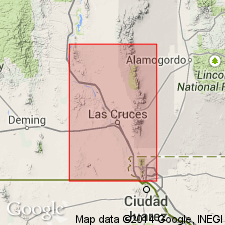
- Usage in publication:
-
- Benigno limestone
- Modifications:
-
- First used
- Dominant lithology:
-
- Limestone
- AAPG geologic province:
-
- Orogrande basin
Summary:
First published use of name. Intent to name not stated; no type locality designated. Thick sequences of Cretaceous rocks are on the southeast edge of La Mesa in Cerro de Cristo Rey and Sierra de Juarez, Dona Ana Co, NM in the Orogrande basin. La Mesa is part of the Mesilla Bolson, bounded on the west by the East Potrillo Mountains, West Potrillo Mountains, Aden Hills, Sleeping Lady Hills, and Cedar Hills, and on the east by the Robledo Mountains (at the north tip of La Mesa) and the Rio Grande Valley. In Sierra de Juarez, the Benigno Limestone consists of massive rudistid reefs 400-600 ft thick. [Areal limits not given.] Overlies Cuchillo Formation; underlies Lagrima Formation (first used) [nature of contacts not discussed]. In East Potrillo Mountains, southwest side of La Mesa, Cretaceous beds have been tentatively correlated with Sierra de Juarez' Cuchillo, Benigno, and Lagrima Formations. Age given as Cretaceous.
Source: GNU records (USGS DDS-6; Denver GNULEX).
For more information, please contact Nancy Stamm, Geologic Names Committee Secretary.
Asterisk (*) indicates published by U.S. Geological Survey authors.
"No current usage" (†) implies that a name has been abandoned or has fallen into disuse. Former usage and, if known, replacement name given in parentheses ( ).
Slash (/) indicates name conflicts with nomenclatural guidelines (CSN, 1933; ACSN, 1961, 1970; NACSN, 1983, 2005, 2021). May be explained within brackets ([ ]).

